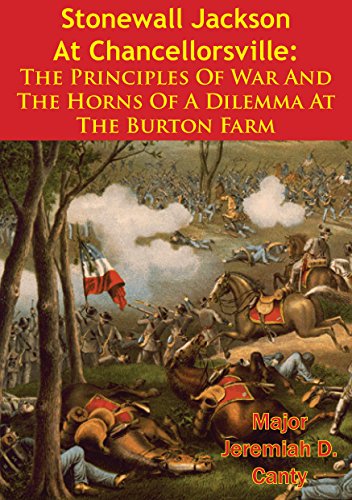Stonewall Jackson At Chancellorsville: The Principles Of War And The Horns Of A Dilemma At The Burton Farm by Major Jeremiah D. Canty
English | Feb 22, 2015 | ASIN: B00TXVM4P6 | 91 Pages | PDF (Converted) | 2 MB
English | Feb 22, 2015 | ASIN: B00TXVM4P6 | 91 Pages | PDF (Converted) | 2 MB
The Battle of Chancellorsville in May 1863 and particularly the Flank March and Attack under Jackson served as a metaphor for the operational victories the South gained while at the same time signifying why the South could not hope to win strategically based on a policy of accepting greater levels of risk than its Northern opponent.
In the spring of 1863 the Federal cause had just recovered from the disasters of the previous year with a resurgent army and leadership. In consonance with the Federal policy of all-out attack and relief of command if not successful, General Hooker headed south to try his hand against the nemeses of the North; General Lee and General Jackson. Initially, Hooker was very successful and essentially “turned” Lee’s position at Fredericksburg and south of the Rappahannock by maneuvering across the river before Lee could react. Lee, facing defeat in detail as he attempted to hold off two possible Federal thrusts, was galvanized into action that seemed to defy the military principles of the day. Dividing his already heavily outnumbered army Lee attacked the eastern most elements of Hooker’s army that was south of the river. The unexpected thrust unnerved Hooker who withdrew back into the Wilderness to fall back on defensive positions in anticipation of further Confederate attacks. Lee and Jackson realized they had no choice but to attack the Federals and decided on yet another division of the army, in further defiance the principles of war. Even though Hooker correctly appreciated Lee’s intent he failed to take adequate precautions against a Confederate move from the west. In spite of being observed on several occasions the Second Corps of “Stonewall” Jackson arrived on the flank of the Federal army and delivered one of the most crushing blows of the war. Lee and Jackson’s ability to absorb levels of risk that were not feasible for Hooker to accept gave them a distinct advantage over the Federal commander and thus acted as a significant force multiplier. By using tempo to compensate for inferior numbers and to move progressively faster inside Hooker’s decision making cycle they achieved a notable success, but one that did not have any great strategic impact.
The relentless pursuit by the Confederacy of operational victories in the hope of forcing the North to give up the attempt at reunion saw its last, but ultimately Pyrrhic victory at Chancellorsville. The predictable assumption of risk would no longer pay off. After Chancellorsville the waging of operational conflict on the margin, that is to say leaving no room for error, came to its predictable conclusion on the fields of Gettysburg two months later.



